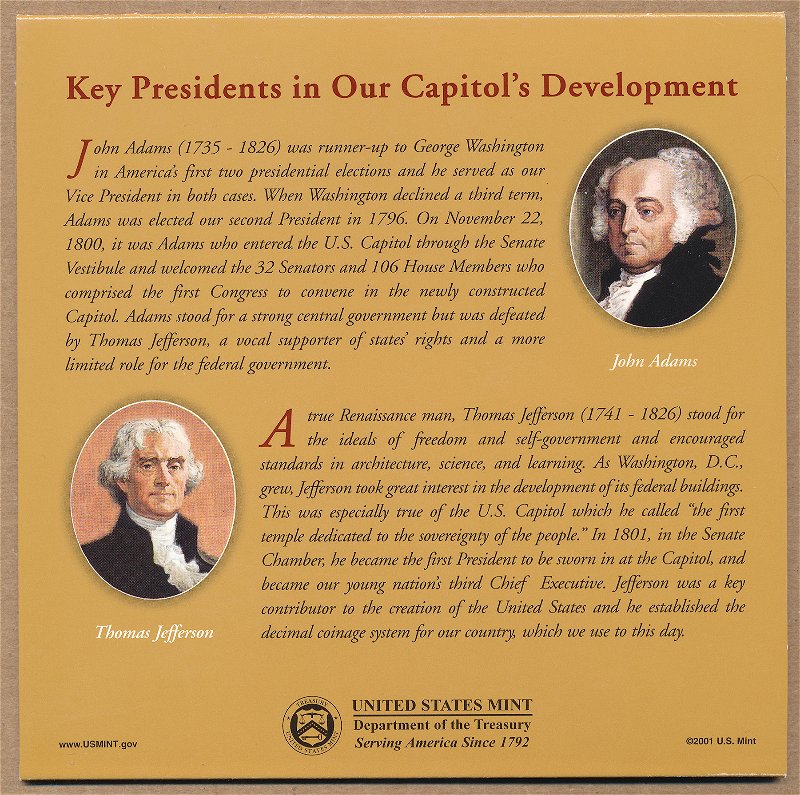Back in March 2015,
spaceace posted about a 2001 US Mint commemorative set picked up at a coin show - the coin in the set was the 2001 US Capitol Visitor Center clad half dollar. To view the set, a link was included to a listing on
ebay -- of course, the lot is now long gone. You can read the original thread here:
US Capitol Visitor Center Collector's Set.
I thought I would do a quick post on the set, add a few details and provide some images that could serve as a more permanent record.
As a bit of background, the 2001 US Capitol Visitor Center commemorative program included a gold $5 coin (half eagle), a silver dollar and a CuNi clad half dollar. Each coin was available in Proof and Uncirculated; the gold coins were struck at West Point, the silver dollars and half dollar options were struck in Philadelphia. The coins went on sale on February 28, 2001 at noon (Eastern).
Though the authorizing legislation for the coins is titled "United States Capitol Visitor Center Commemorative Coin Act of 1999" and directs that all surcharges collected via coin sales to be "deposited in the Capitol Preservation Fund...for the purpose of aiding in the construction, maintenance, and preservation of a Capitol Visitor Center," the coins were meant to commemorate the first meeting of the United States Congress in the new United States Capitol Building in Washington, DC.
The 6th US Congress began its 1st session on December 2, 1799 in Philadelphia, PA; it met in Philadelphia through May 14, 1800. The Congress' 2nd session convened on November 17, 1800 in the new Capitol Building in Washington, DC; the session continued through March 3, 1801. Congress' first meeting in the new US Capitol was fairly brief, lasting approximately 3-1/2 months. The building has been in continuous use ever since!
The obverse of the half dollar presents the small original Capitol Building superimposed over a background outline image of the circa 2001 Capitol; it was designed by Dean McMullen. The design also includes a horse-drawn carriage, circa 1800.
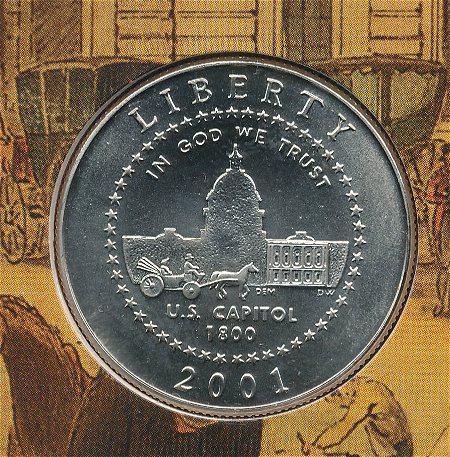
Alex Shagin and Marcel Jovine co-designed the coin's reverse which is mostly commemorative and statutory inscriptions. The 16 stars included on the reverse are meant to represent the 16 states that were part of the Union in 1800.
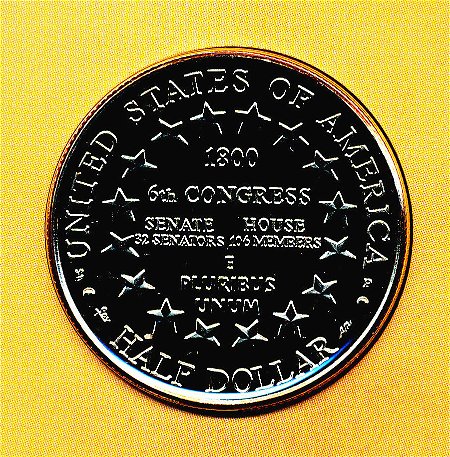
When it opened, the small original Capitol Building housed not only the Senate and House of Representatives, but also the Supreme Court and the Library of Congress. The courts of the District of Columbia were also allocated space in the building. It was a simpler time!
There were three ways to purchase the
uncirculated version of the clad half dollar: 1) in a Mylar pocket inside a full-color envelope ($8.75 pre-issue / $9.75 regular), 2) in a capsule with a plain cardboard mailer ($7.75 / $8.75) and 3) in the colorful Collector's Set folder ($16.50 / $17.50). The Mylar pocket and plain encapsulated versions came with a separate, printed US Mint Certificate of Authenticity (COA).
The multiple packaging options of this program were an experiment by the US Mint. It gave collectors the option of saving a few dollarse by purchasing either the gold, silver or clad coins in a capsule with a cardboard mailer vs. typical packaging. Sales apparently were not strong enough, however, as the Mint did not offer the simpler packaging option directly yo consumers in future programs (bulk purchasers of modern US commemoratives continue to have the capsule-only option, however).
The Collectors Set was reasonably popular with collectors, selling 31,256 copies, which was more than the mylar pocket version (17,910 units sold) or the plain encapsulated coin (13,416 coins sold).
(Note: All of these figures are for the uncirculated version of the coin.)The maximum authorized mintage for the half dollar (across all options) was 750,000. When the program closed, 77,962 of the proof half dollars were sold and 99,157 of the uncirculated coins for a total of 177,119. Each half dollar carried a $3 surcharge, thus the half dollar contributed about $531K (of the $2.2 million program total) to the fund earmarked for the Visitor Center.
IMO, the Collector's Set is an informative product that provides a collector with some great information about the early development of the US Capitol Building.
Hope you enjoyed learning about the set!
2001 US Capitol Visitor Center Collector's Set: Outer Sleeve - Front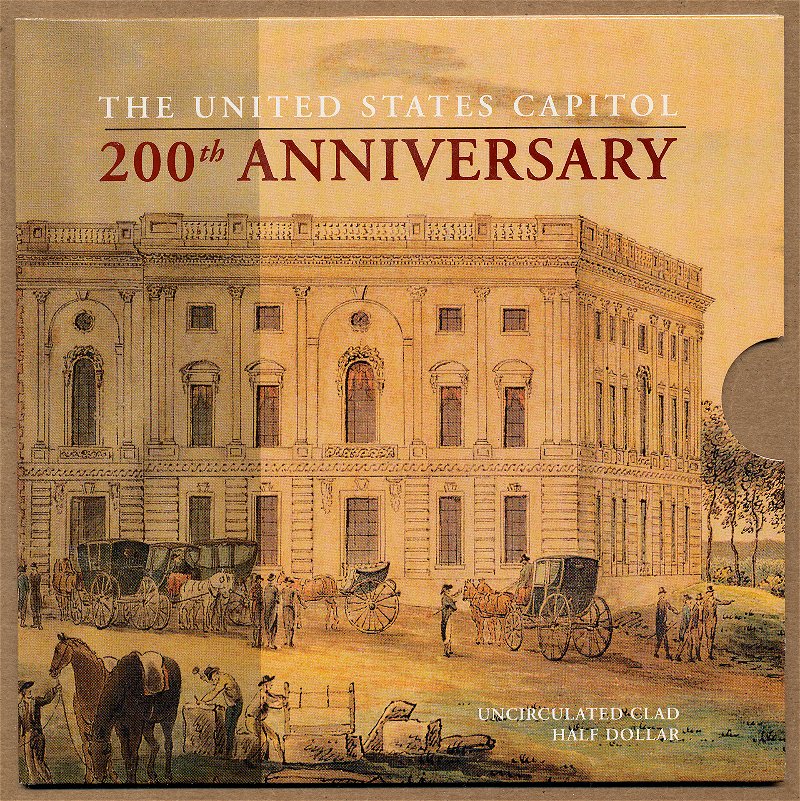 2001 US Capitol Visitor Center Collector's Set: Outer Sleeve - Back
2001 US Capitol Visitor Center Collector's Set: Outer Sleeve - Back 2001 US Capitol Visitor Center Collector's Set: Folder - Front Panel
2001 US Capitol Visitor Center Collector's Set: Folder - Front Panel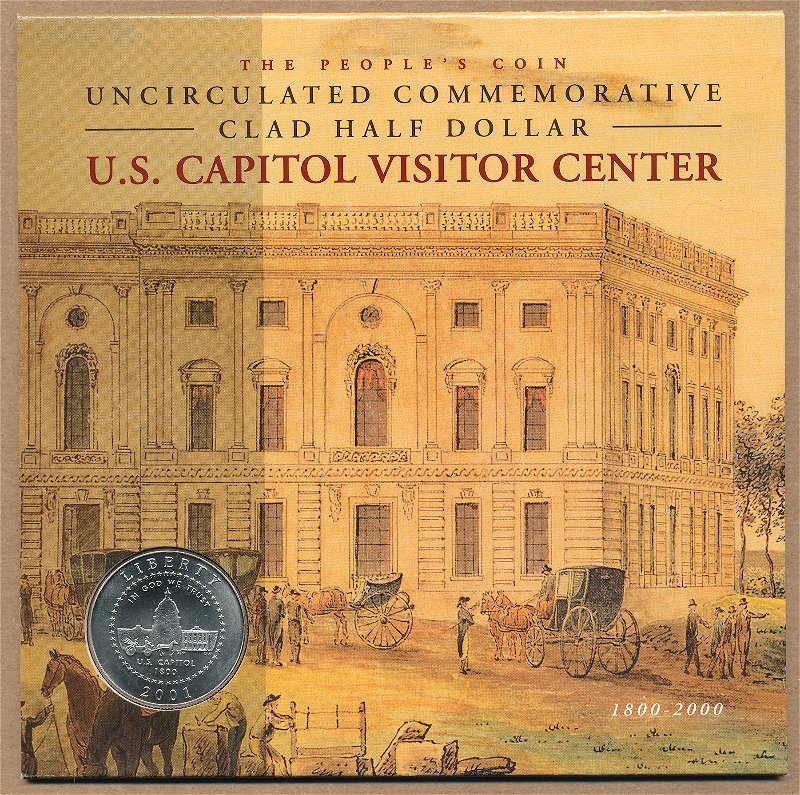 2001 US Capitol Visitor Center Collector's Set: Folder - Inside, Top Panel
2001 US Capitol Visitor Center Collector's Set: Folder - Inside, Top Panel 2001 US Capitol Visitor Center Collector's Set: Folder - Inside, Bottom Panel
2001 US Capitol Visitor Center Collector's Set: Folder - Inside, Bottom Panel 2001 US Capitol Visitor Center Collector's Set: Folder - Back Panel
2001 US Capitol Visitor Center Collector's Set: Folder - Back Panel